Masterpiece Story: Ground Swell by Edward Hopper
Edward Hopper created his peaceful seascape masterpiece Ground Swell with hinted implications of social disengagement, emotional loneliness, and...
James W Singer 21 April 2024
The Ghent Altarpiece (or The Adoration of the Mystic Lamb) by brothers Hubert and Jan van Eyck, is one of the superstars of art history. If anyone ever tells you that art history is boring, share this fascinating tale with them. This epic yarn spans 500 years and involves Nazi thieves and salt mines, sinister clergymen and pornography, revolutionary painting techniques, and mind-bending conspiracy theories. Are you ready for a whirlwind story? Read on!
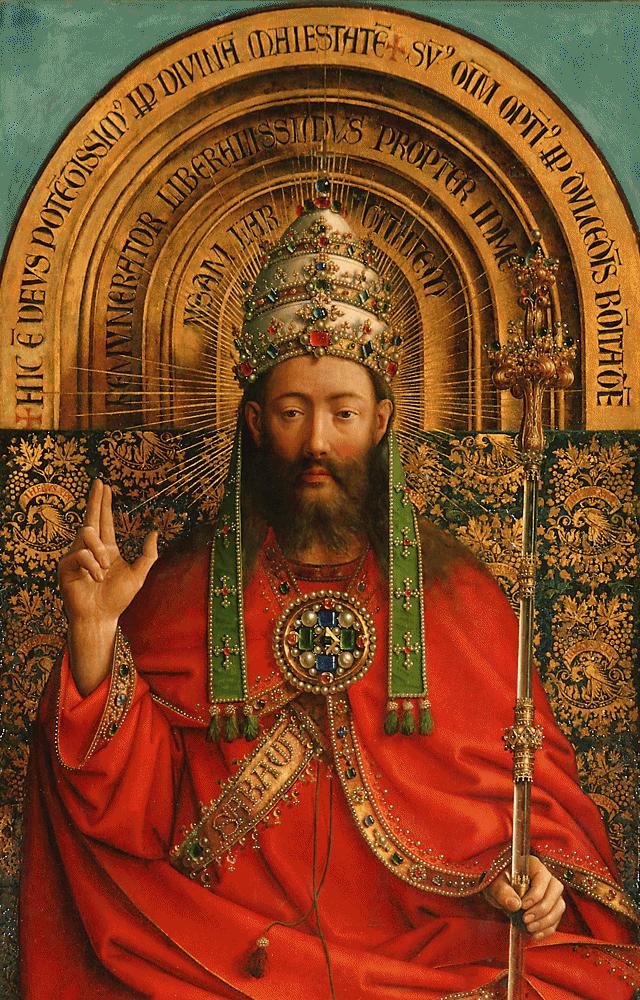
Jan van Eyck, Ghent Altarpiece, 1432, St Bavo’s Cathedral, Ghent, Belgium. Detail of The Almighty.
So, we’ll save the wild theories for later and start with some basic facts. The Ghent Altarpiece was completed in 1432. It is a whopping 3.5 m x 4.6 m (11.1 ft x 17 ft) and is known as a polyptych—meaning it has multiple folding, hinged panels, so it can be viewed open or closed. There are 18 panels and 24 individual paintings. In its St Bavo’s Cathedral location, it would have been closed for much of the year and opened only during feast days and celebrations. What a reveal that must have been! Imagine when the congregation saw the forgiving, redeeming God of the Renaissance in place of the vengeful medieval God (image above).
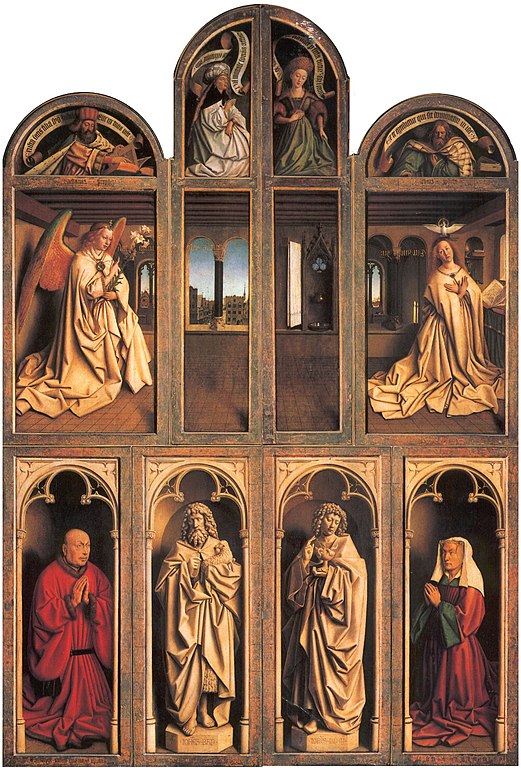
Jan van Eyck, Ghent Altarpiece (closed view), 1432, St Bavo’s Cathedral, Ghent, Belgium.
The altarpiece is by Flemish Renaissance painters Jan van Eyck and his older brother Hubert van Eyck. Completed over six years, it shows a series of Biblical scenes from Catholic mysticism. Wealthy Ghent mayor and alderman Joos Vijd and his aristocratic wife Lysbette Borluut commissioned the work, and you can see them depicted on the outer panels shown above.
Did their generosity get them into heaven, as they had hoped? It certainly got them into the history books. The Ghent Altarpiece is one of the world’s first-ever oil paintings. Previously artists mixed colored pigments with egg yolk, but at this point in history, they discovered that using oils, pigments, and transparent glazes allowed for astonishing results.
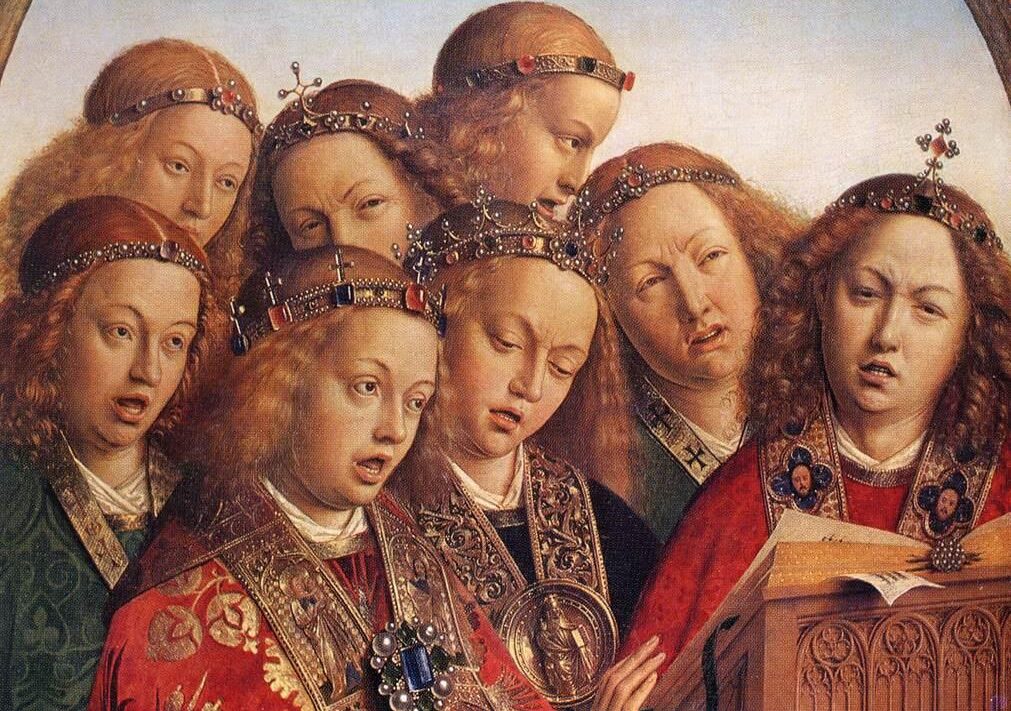
Jan van Eyck, Ghent Altarpiece, 1432, St Bavo’s Cathedral, Ghent, Belgium. Detail of angel choir.
Intelligent and well-traveled, Jan van Eyck brought skill, imagination, and science together to create a work of genius. Did he ever think his work would be so unbelievably popular? Well yes, maybe. Jan van Eyck was an innovator, and his work was much sought after during his lifetime; he was a court painter and an ambassador for royalty.
Jan’s elder brother Hubert designed the overall structure of the altarpiece, but he died before the painting work could begin in earnest. Jan continued with this labor of love, in tribute to his brother. People have crowded to see the altarpiece from the day it was unveiled on 6 May 1432, when it was hailed as the best painting in Europe.
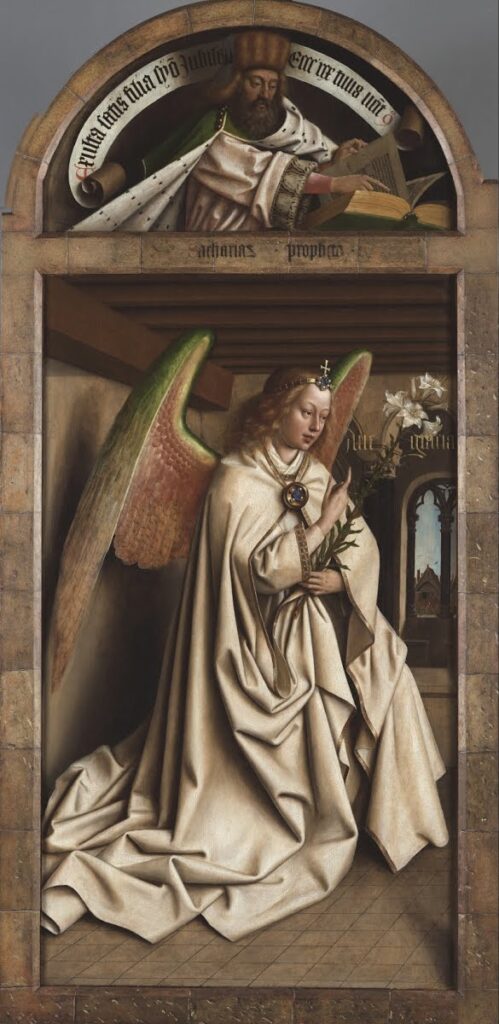
Jan van Eyck, Ghent Altarpiece, 1432, St Bavo’s Cathedral, Ghent, Belgium. Detail of Archangel Gabriel.
Jan van Eyck paid as much attention to the beauty of earthly things as to the divine religious themes in the altarpiece. With new oil painting techniques, he created breathtaking results. The panels contain complex light effects and subtle plays of shadow and reflection. We see sumptuous definition in fabrics like silk, wool, brocade, and fur. We see visual trickery where finely dressed people stand alongside 3D marble stone statues—surely this cannot be a 2D flat painting? Individual faces and hairstyles can be identified. Heavenly scenes can be extraordinarily fantastical—just look at the Archangel Gabriel with their watermelon-colored rainbow wings!
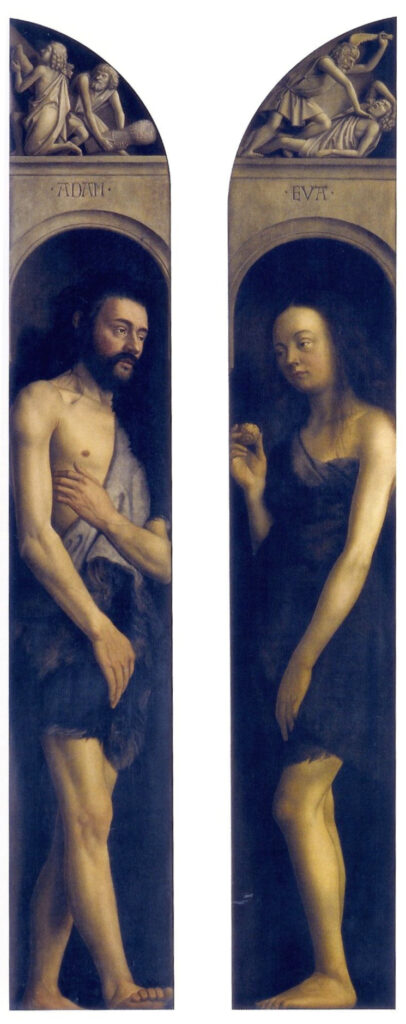
Jan van Eyck, Ghent Altarpiece, 1432, St Bavo’s Cathedral, Ghent, Belgium. Detail of Adam and Eve.
So much visual information can be found in the Ghent Altarpiece, it is almost cinematic. Art historian Erwin Panofsky said of Van Eyck, that his vision was simultaneously a microscope and a telescope. We see meticulous detail—fingernails, pimples, hairy legs, beard stubble. We see the reflections of a building in a horse’s eye, the reflection of a window within a tiny glittering jewel.
Some details have been painted with a single badger hair. In fact, so unflinchingly realistic were the human bodies of Adam and Eve that in the late 18th century they were taken down and hidden away, censored for their nudity! They did make it out of the dusty archives, but the Victorians insisted their bodies, which they called pornographic, be painted over in furs and skins.
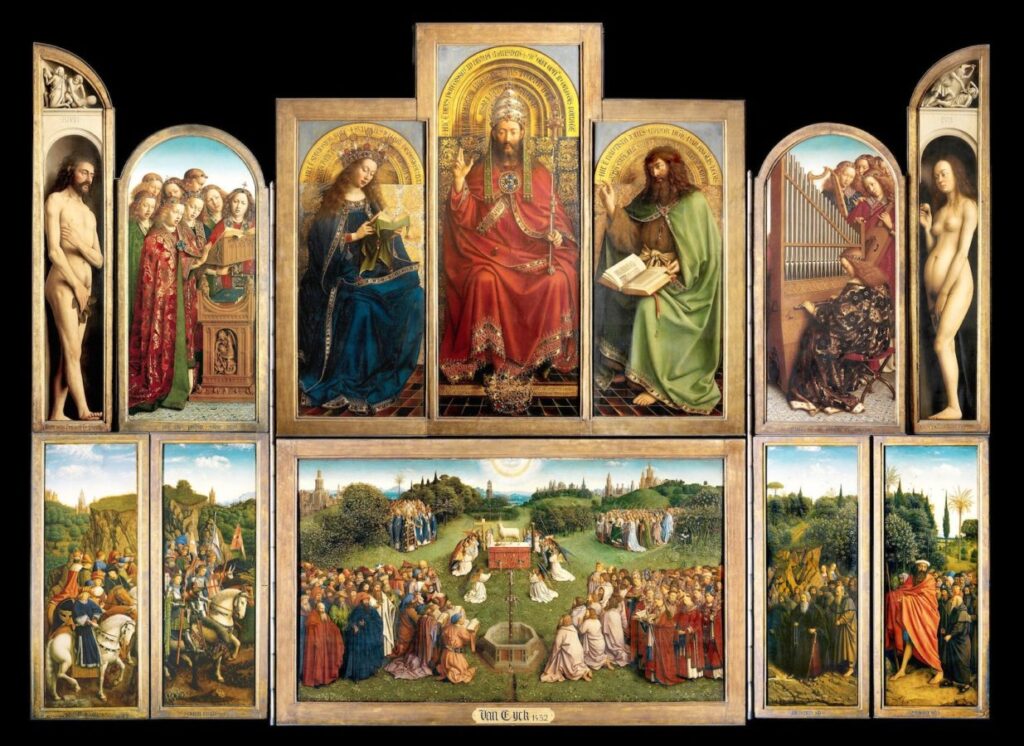
Jan van Eyck, Ghent Altarpiece (open view), 1432, St Bavo’s Cathedral, Ghent, Belgium.
The first 100 years of life for the altarpiece were relatively calm, but then things heated up, literally. In 1566 Protestant militants mobbed the church and attempted to burn the altarpiece, scorning it as idolatrous excess. The ornate carved outer frame (and possibly some internal clockwork mechanisms) were lost or burned around this time.
The altarpiece was stolen during the Napoleonic wars, in the First World War, and again in the Second World War. Hitler wanted the altar and hid it in a secret salt mine. As the war ended, an SS officer tried to blow up the mine, containing 6,000 priceless treasures, but he was stopped in the nick of time. In the 2014 film The Monuments Men, about Allied soldiers rescuing stolen artworks, George Clooney declares that the Ghent Altarpiece is the most important work of art in the Western tradition. Nice one, George!
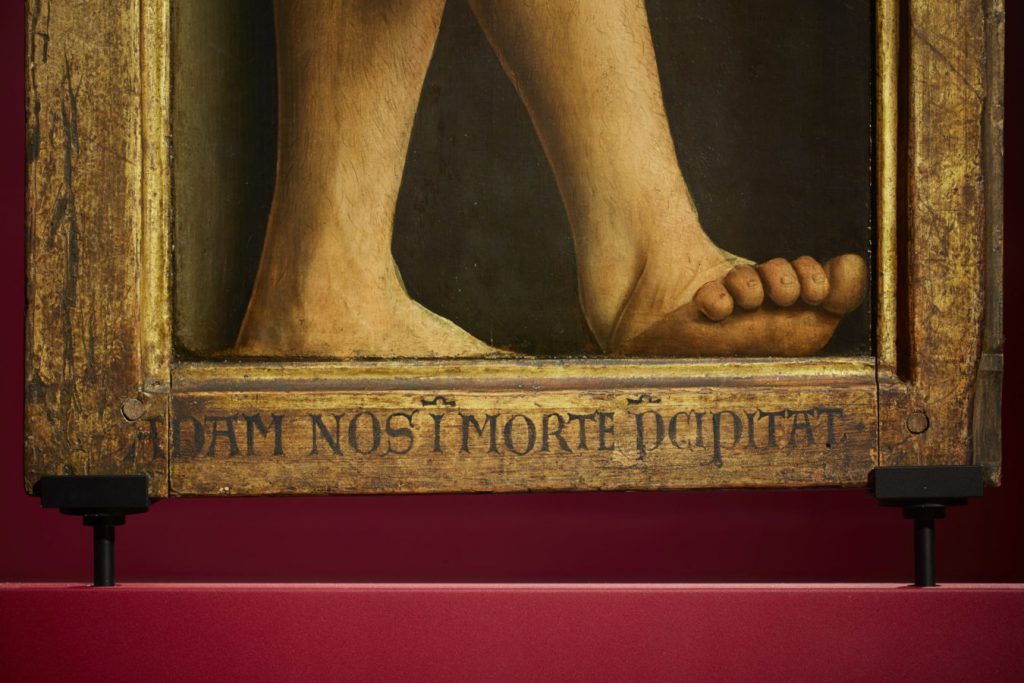
Jan van Eyck, Ghent Altarpiece, 1432, St Bavo’s Cathedral, Ghent, Belgium. Detail.
Even those entrusted with its care could not always be relied upon. A corrupt vicar sold parts of the altar in 1815, to pay off his debts. A museum (the Kaiser-Friedrich-Museum in Berlin) cut the side panels in half vertically in a misguided attempt to exhibit both sides at once. A raging fire in 1822 could have taken the entire structure, but only one panel was damaged.
Then in 1934, two panels were stolen and one (The Just Judges) has never been recovered. The inept officer investigating the theft was more interested in cheese than art, prioritizing a theft of dairy products from a nearby shop. Multiple ransom notes were received, and some believe members of the clergy and a Ghent stockbroker were involved. To this day the Belgian Police employ a full-time detective to continue the cold-case investigation (seeking the altarpiece, not the cheese).
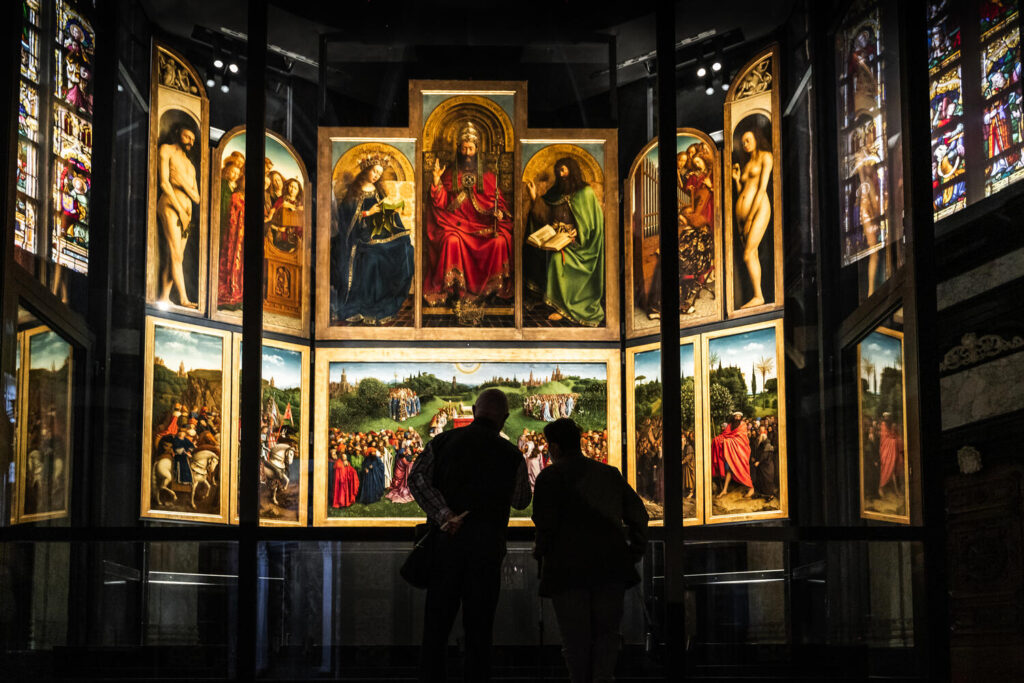
Jan van Eyck, Ghent Altarpiece, 1432, St Bavo Cathedral, Ghent, Belgium. Photograph by Martin Corlazzoli © Sint-Baafskathedraal. visitghent.be.
Today, the Ghent Altarpiece is considered one of the world’s greatest art treasures. Housed within a bullet-proof case inside a purpose-built visitor center within St Bavo’s Cathedral, over a million visitors and pilgrims flock to this ravishing artwork every year. A hugely complex and detailed work, it contains 100 individual figures and 70 different species of flowers and trees. We have Mary and Joseph, Adam and Eve, Old Testament prophets and sibyls, martyrs, hermits, knights, angelic choirs, and at the center, on an altar, stands the Sacred Lamb, bleeding into a chalice, symbolizing the sacrifice of Christ.
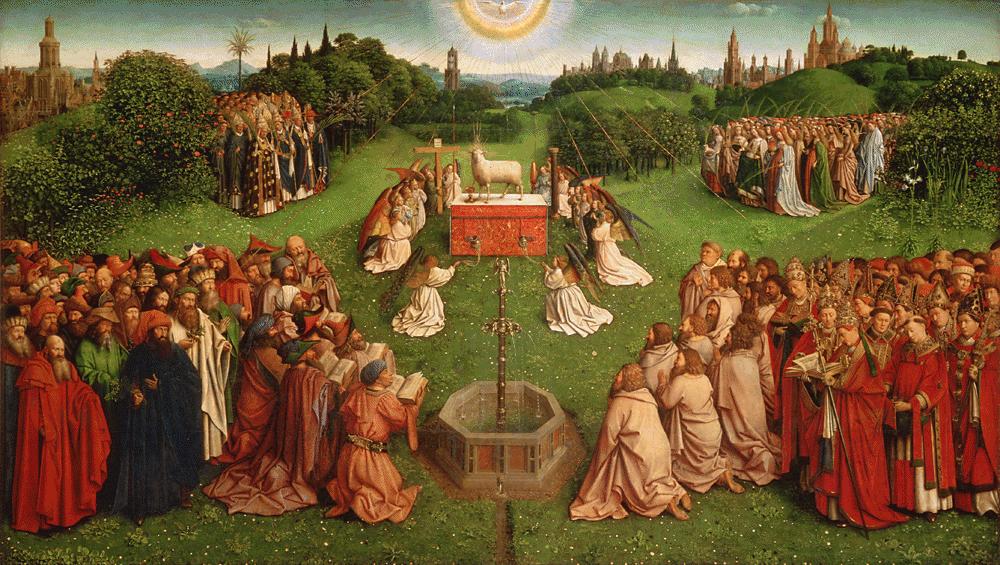
Jan van Eyck, Ghent Altarpiece, 1432, St Bavo’s Cathedral, Ghent, Belgium. Detail of central panel.
Art restoration has a checkered history. It can reveal ravishing precision, or it can destroy priceless detail. The Ghent Altarpiece has been restored many times, including in 1550, 1832, and again in 1950. More recently in 2020, a 1.3 million euro restoration project revealed radiant details, vivid colors, and unknown secrets. The specialist team used a scanning technique called macro X-ray fluorescence analysis. All of this work can be viewed in microscopic detail via a purpose-built website.
One of the most astonishing revelations is that 70 percent of the exterior panels had been painted over. The modern investigation and restoration have allowed us to access a rich source of information about medieval fauna, flora, and geology, as well as architectural and domestic particulars from medieval Flanders. The complex restoration works are planned to finish in 2026. Until then, seven panels of the Ghent Altarpiece can be viewed at the Museum of Fine Arts in Ghent.
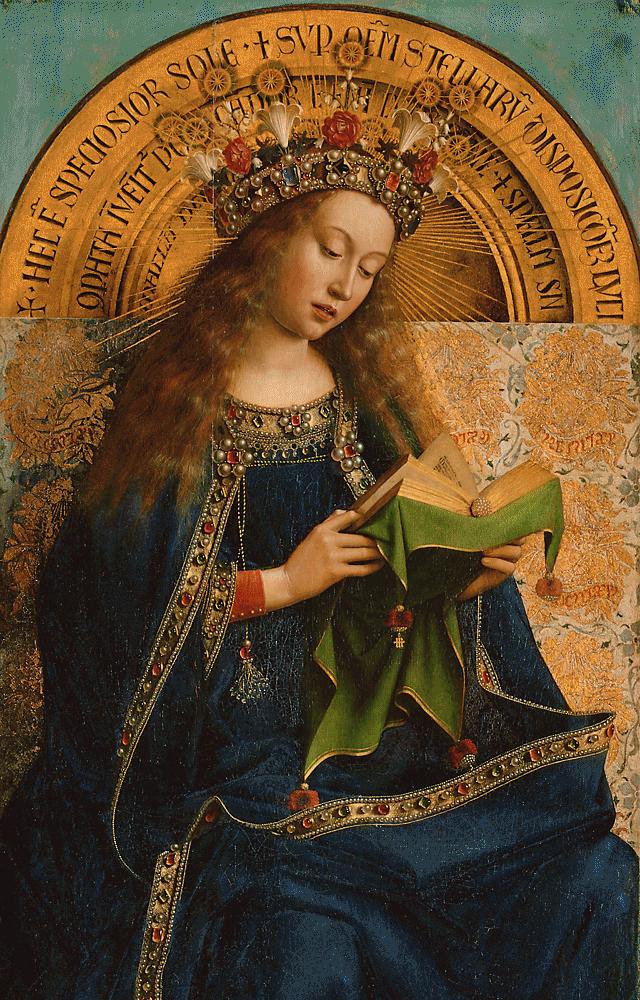
Jan van Eyck, Ghent Altarpiece, 1432, St Bavo’s Cathedral, Ghent, Belgium. Detail of Mary.
The most stolen, the most famous, the most over-painted, the most traveled piece of art. The life of the mystic lamb has been turbulent. It has led a perilous yet charmed life. Five centuries after its first unveiling, it remains a thrilling and sublime art experience. This is a work you could spend every day of your life exploring and still find new joys. If you are interested in a watershed moment in art history, you must head to Belgium to see this magnificent work in all its glory. Belgian waffles, chocolate, and beer are also quite delicious if you need further enticement!
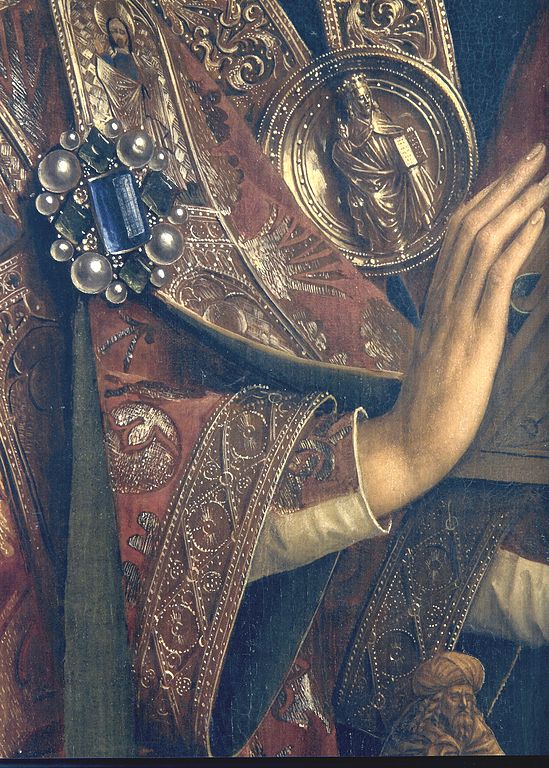
Jan van Eyck, Ghent Altarpiece, 1432, St Bavo’s Cathedral, Ghent, Belgium. Detail.
Want to learn more about this masterpiece? Noah Charney presents a five minute, engaging animation of the history of the Ghent Altarpiece in this TED talk:
And to get a closer look at the Ghent Altarpiece from the comfort of your home or local library, check out the Closer to Van Eyck website which presents a 100 million-pixel photographic enlargement project!
DailyArt Magazine needs your support. Every contribution, however big or small, is very valuable for our future. Thanks to it, we will be able to sustain and grow the Magazine. Thank you for your help!